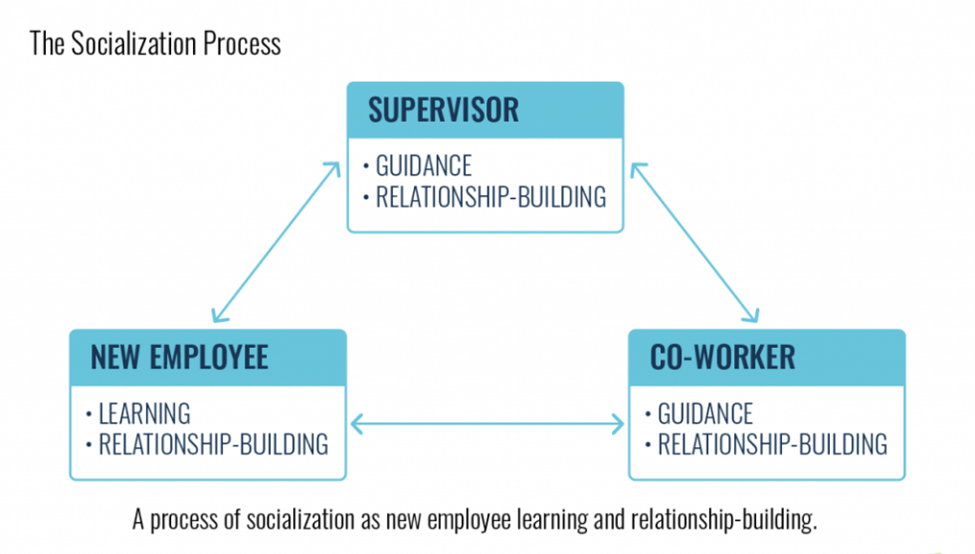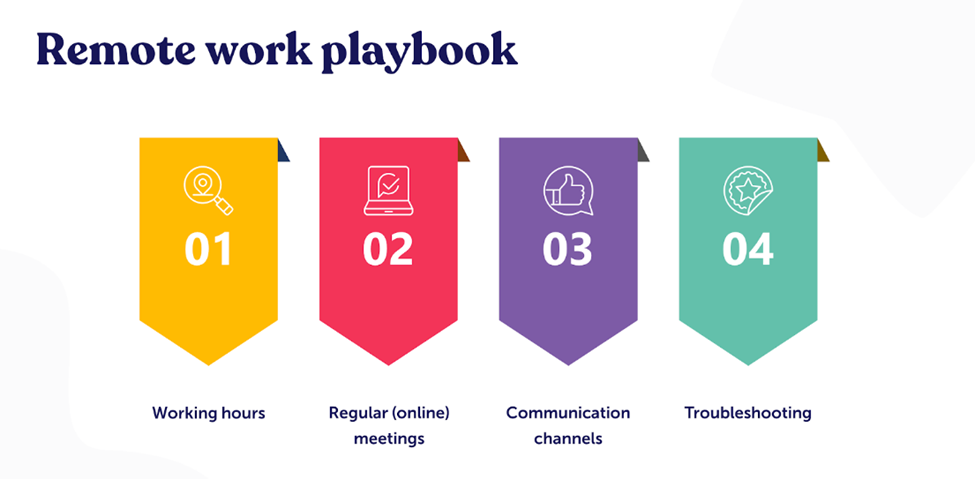Even though your remote workers are all at home and might not even be in the same nation as they work, employers could and should develop a friendly and helpful corporate culture for them. Quantum Job's employee engagement survey found that 81% % of hybrid employees and 78% of remote employees are satisfied with their work environment.
It's best to work together toward similar objectives despite their geographical separation. If a solid culture can be achieved, workers spread around the company might benefit from a more cohesive and collaborative remote culture.
Here are 11 ways that companies can nurture employee development within their remote teams:
1. Onboarding should reflect the ideals of your business.
You have a unique opportunity with remote onboarding to virtually share your company's beliefs and culture with your new team members and make a solid first impression. New hires should learn about your company's values and see how they are implemented right away.
These ideas guide the work and connections throughout your firm. Making your values part of the onboarding process helps new hires realize how they fit in and what they can do for the company's culture. An employee handbook, pre-recorded videos, meetings, and 1:1 check-ins should all be included in your remote onboarding materials.
A remote work policy in your company's employee handbook can ensure everyone stays on track with their tasks by outlining what is expected of them regarding their conduct, such as their work hours while they are working from home.
It is also essential to have an orientation buddy to help new hires get acclimated to their unique setting. Plan regular dates for your orientation couples to meet since Microsoft found that having them meet more often helped their new employees become more productive more quickly.
2. So make the most of your YOOO (You Only Onboard Once) experience!

Close the gap between you by meeting face-to-face.
Reducing the isolation of telework, which may be created by workers looking at screens all day instead of engaging with other people, is an integral part of developing a lively remote work culture.
Even though your remote team may never meet in person due to their geographical separation, they may have frequent face-to-face meetings using video conferencing software. Employees should be able to laugh and joke around in meetings when cameras are allowed to be turned on.
Through video conversations, there are several options for face-to-face encounters. At all-hands meetings, you may view the whole business at once or engage personally with colleagues in 1:1 meetings or stand-ups each day.
You can also have weekly team meetings or daily stand-ups with your coworkers. By holding "lunch-and-learn" gatherings, you may learn more about your coworkers while also building virtual teams.
3. Avoid "death by meeting" at all costs.
You don't want workers to dread attending meetings, even if they must be held remotely. Implement these recommended practices for your remote team to avoid "Zoom fatigue" and other meeting-related exhaustion: There was no reason to meet.
Avoid wasting employee effort and time if you don't need them to meet to discuss a particular issue or topic. If it's possible, use an announcement or message to convey information.
Make a plan in advance of meetings to keep them brief and focused:
- Make sure there aren't a lot of back-to-back meetings or ones that are too lengthy. Rest before returning to your next meeting or concentrating on complex tasks.
- Avoid arranging long meetings earlier than usual in the day if you have workers dispersed throughout different time zones. Pilot, for example, has specified meeting hours that are convenient for our remote team members.
- It's best not to make it mandatory to have cameras on at all times. Virteria conducted a poll in 2021 and found that over half of those surveyed reported feeling more tired since they were on camera during online meetings.
- Increase the efficiency of your communication by using digital collaboration tools and tactics. Gaining your workers' confidence and fostering a collaborative working environment are made possible by establishing open lines of communication between your team members.
- Using platforms like Slack or Microsoft Teams to facilitate the exchange of ideas, communication, and social cohesiveness has become almost universal. In fact, by 2021, approximately 80 percent of employees should be utilizing digital tools for collaboration. They're a great way to keep everyone on the same page while fostering open dialogue on various topics.
To ensure that everyone understands how and where to get information and express their ideas, you should list the practical tools for each kind of communication. A wiki or Google Docs is suitable for training and documentation, while Slack, Webinar meetings, and emails are available for urgent issues.
However, your tools are only as successful as how you use them to interact with your staff, so it is crucial to be competent in utilizing them.
4. Transparency in Communication
Inquire about how, when, and how frequently your direct reports want to be kept in the loop. Transparency in communication is a virtue you should always strive to uphold. As a manager, it's essential to be upfront and honest with your employees about how things are progressing.
One good practice could be to use asynchronous communication that allows everyone to check things out at their convenience without interfering with the rest of their day's work. Best practices in async communications enable your scattered team to interact more efficiently.
To that end, advocate using Slack messaging or emails instead of in-person meetings wherever feasible. Doist, for example, requires its team members to react within 24 hours; this natural response time allows for some wiggle room.
Employees don't need to be constantly barraged with messages while working from home. Consider the time zone differences of your overseas personnel when communicating with them.
5. Accomplishments should be praised and rewarded.
Workers will feel more connected to the company when recognized for their hard work. According to SurveyMonkey, 82% of workers consider recognition a vital element of their overall satisfaction with their workplace and ability to stay employed.
Sixty-three percent of those who are "always" or "usually" recognized at work are "very unlikely" that they would hunt for a new position within the next 3 to 6 months.
6. Celebrate Achievements

Celebrate professional and personal achievements with your colleagues, such as anniversaries and promotions at work and the birth or adoption of a child. And a viral marketing campaign or surpassing key performance indicators (KPIs) should be publicly recognized.
As a group, we may celebrate our successes together by highlighting the achievements of others. As a result, the organization reaps the benefits of that pleasant fuzzy sensation.
According to Deloitte, organizations with a culture of employee appreciation saw an increase in engagement, productivity, and performance of their workforce of 14%. One strategy to assure increased happiness and develop healthy work relationships is by openly appreciating one other for the things we accomplish well.
7. Encourage a well-balanced work-life schedule.
When working remotely, workers may feel the need to be "always on," which may lead to overwork. Working more than 50 hours weekly is more common for remote and hybrid employees. To help your employees create boundaries, you might foster a teleworking culture that encourages people to "turn off" and prioritize their personal life.
According to a FlexJobs poll, three out of four remote employees said they'd experienced burnout. You can assist your remote workers in preventing burnout by ensuring that they have enough time to relax and unwind.
8. Don't hold yourself back from taking advantage of flexible working hours.
The freedom to work from anywhere is one of the best benefits of remote employment, so make the most of it. Workers may choose a schedule that fits their plans rather than being confined to the typical 9-to-5. Allow workers to come and go as they choose. Make it possible for them to go to school or walk the dog if needed.
9. Logging off is a time for workers to unplug entirely.
Everyone is entitled to vacation from their jobs. It's your responsibility to see that they take it and that their work doesn't get in the way. Considering we can check our email in bed, it's difficult for us to maintain the line between work and personal time.
Let workers know they are expected to work a specific number of hours each day and discourage them from checking their email or responding to work issues after hours or on the weekends. To be clear, this relates to paid vacation time (PTO), too.
Encourage your employees to use their collected PTO. It is essential for workers to disengage from their computers while on PTO so they can genuinely enjoy their time off, rest, and reset.
Set up automated out-of-office vacation responder emails for when your employees are away from the office to ensure their time off is safeguarded. The statuses of your Slack team members can update to indicate that they are on vacation or out of the office until a specified date.
10. Provide health care for workers.
Mentally and physically fit employees are better equipped to do their jobs. Found in a 2018 research, participation in an employee health and wellness program can increase productivity by 5 to 11%. Your company's health is enhanced when you encourage your workers to take responsibility for their well-being by offering a variety of benefits, such as health insurance, paid time off for counseling, and discounted gym memberships.
There is no obligation to pay for these non-insurance health benefits, but it's a nice added bonus for many workers. Employees who work from home enjoy the flexibility to sleep or work out more since they have the option to do so at their convenience.
11. Encourage chit-chat and "watercooler" conversations outside of work.
Taking a vacation from the workplace may still be helpful, even if we understand that not every workweek is successful in its totality. Stopping by the "water cooler" in the corridor for a quick talk with your colleagues may increase productivity by up to 15%. When it comes to totally remote, virtual workplaces, the "watercooler effect" may be recreated:
- Set up a Slack channel dedicated to non-work issues such as pets and hobbies, children, and side hustles. Employees may use these channels to show off their interests and interact with others who share them.
- For team-building activities, a pleasant virtual hour, a company lunch, a reading club or movie night, and in-person meet-ups should be promoted whenever possible.
- Ask a discussion starter or icebreaker in Slack channels or during meetings as often as possible.
- Simulate the watercooler effect by using tools or bots. Random employees who choose to "run into" each other at a meeting, as they would in the workplace, may be scheduled automatically by Donut and Snack, for example.
It's always a work in progress to build a thriving remote culture. In the same way that Rome wasn't built in a day, you can't create a culture overnight. If the demands of your employees change, you must be ready to adapt your strategy. Do regular employee engagement surveys to keep in touch with your workers' feelings. Monitor your remote work processes and be prepared to implement new initiatives if necessary, especially when something isn't working.
Lastly, many apps can help when it comes to the business end of remote work. Instead of worrying about compliance issues, these apps can take care of them and ensure that your remote workers are paid on time and in their local currency.
About the Author: Darakhshan Roohi is a Pakistan-based content specialist focused on cryptocurrency, Fintech, and ERP-based business solutions. She is a freelance writer and part of groundbreaking cryptocurrency content presently under work!



%20Size%20Photos/Successful%20business%20group%20%20celebrating%20at%20the%20office-2.jpeg)



